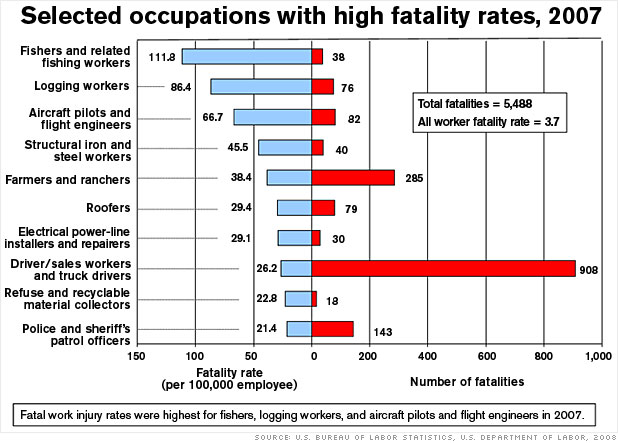America's most dangerous jobs
Fishermen, loggers and pilots saw the most deaths in 2007, but total workplace fatalities were actually down 6%.
NEW YORK (CNNMoney.com) -- Fishing, flying and logging were the three most dangerous jobs in America in 2007. These occupations reported higher death rates than any others, according to a report out Wednesday from the Bureau of Labor Statistics (BLS).
Total workplace fatalities dropped in the United States during 2007. More troubling is the fact that the number of murders in the workplace jumped substantially.
Some 5,488 people died from injuries on the job last year, or 3.7 out of every 100,000 workers, according to the report. That's the fewest job fatalities recorded since the Bureau began collecting these statistics in 1992, and a 6% drop from the 5,840 in 2006.
But there were 13% more workplace homicides last year than in 2006, according to the BLS's latest Census of Fatal Occupational Injuries. The increase brought the number to 610 from 540 in 2006. Still, that's a big improvement over the 1,080 murders recorded in 1994, the peak year on record for workplace homicides.
Fishing was the most dangerous occupation for the third year in a row. There were 111.8 fatalities for every 100,000 fishermen during the year. Fishermen labor in all sorts of weather, often in small boats on the open water where they can be swept overboard and drown. And they also handle heavy power equipment, such as winches and hoists, that can inflict terrible injuries.
But one of the most feared dangers for fishermen in northern states is ice, according to Tom Rudolph, spokesman for the Cape Cod Hook Commercial Fishermen's Association.
"When ice forms in the (ship's) rigging and above the water line it can have a dramatic and dangerous effect," he said. "The boat can roll."
At the same time, fishing has become a less profitable endeavor, as fish stock grow depleted and fuel costs skyrocket.
"Times are tough," said Rudolph. "Not many young people are going into fishing. Some days it's tough to find a crew. Some fishermen are going out what they call 'single-dory' - working alone."
When they're 100 miles out to sea with no one else aboard, there's no one to help should they get in trouble.
The second most dangerous occupation is logging, where 86.4 workers per 100,000 died. That was an increase from 2006 when there were 82.3 fatal logging injuries for every 100,000 workers, but down from four years ago when, with more than 92 deaths per 100,000, logging led the nation in deaths on the job.
"Logging has become less dangerous because of mechanization," said Eric Johnson, editor of the Northern Logging & Timber Processing magazine. Instead of working with chain saws on the ground, loggers now often sit in the steel enclosed cabs of big machines. The loggers work the controls that send chain saws out into the trunk of a tree from a safer distance.
Still, there are many ways to get hurt. Loggers working outside can get crushed when trees fall in the wrong direction. And big broken branches snagged high up in the treetops often drop unexpectedly as the trees come down.
"They call them widow-makers," said Johnson.
Once logs are cut up, they have to be hauled to trucks. Loggers have big tractors with power winches attached to chains, which skid the logs through the forest. Get in the way and you can be hurt. Sometimes a big piece of wood can splinter off and hit someone.
And when there is a logging injury, help is often far away. Cell phones may not work in a forest, and helicopters can't land, which means that workers who could be saved, lose their race with time.
Commercial pilots also had a bad year, with 66.7 workers out of every 100,000. Still, that was an improvement from 2006, when commercial pilot was the second most dangerous job in America.
Small scale operations, such as bush pilots in Alaska ferrying fishermen and hunters into wilderness areas, account for many pilot fatalities. These flyers may be inexperienced, and their planes often aren't well maintained. Those new to an area sometimes get lost in unfamiliar territory or due to low visibility.
Construction is also a dangerous job. One category of construction jobs, structural iron and steel workers, incurred 45.9 fatal injuries last year for every 100,000 workers, down from 61 in 2006.
Job fatality figures released for each state revealed that Texas had the highest number of deaths - 527, up nearly 8% from 2006. That accounted for nearly 10% of the U.S. total. Rhode Island, with just 5 on the job deaths, had the fewest.
All the numbers released Wednesday were preliminary figures with final results due out in April, 2009. ![]()




